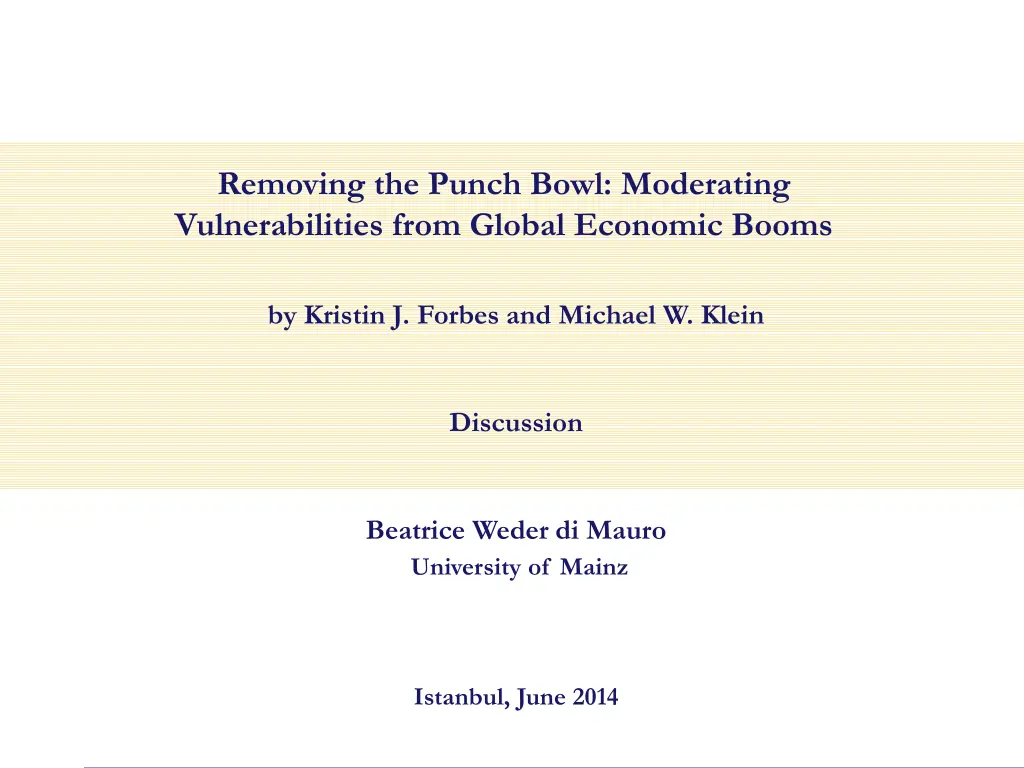
Modelling Policy Choices and Economic Outcomes
Delve into the discussions led by Kristin J. Forbes, Michael W. Klein, and Beatrice Weder di Mauro, exploring the effectiveness of various policy instruments in moderating global economic booms. The paper analyzes key policy choices, implications of macroprudential measures, and the impact of selection bias in policy decision-making. Gain insights into the interplay between fiscal, monetary, and regulatory policies in shaping economic outcomes during booms and crises.
Download Presentation

Please find below an Image/Link to download the presentation.
The content on the website is provided AS IS for your information and personal use only. It may not be sold, licensed, or shared on other websites without obtaining consent from the author. If you encounter any issues during the download, it is possible that the publisher has removed the file from their server.
You are allowed to download the files provided on this website for personal or commercial use, subject to the condition that they are used lawfully. All files are the property of their respective owners.
The content on the website is provided AS IS for your information and personal use only. It may not be sold, licensed, or shared on other websites without obtaining consent from the author.
E N D
Presentation Transcript
Removing the Punch Bowl: Moderating Vulnerabilities from Global Economic Booms by Kristin J. Forbes and Michael W. Klein Discussion Beatrice Weder di Mauro University of Mainz Istanbul, June 2014 13 June 2014 1/10 Weder di Mauro
Why you should like this paper Ambitious approach, thorough execution, highly relevant policy question : What is the most effective instrument to tame runaway booms? How do macro policies compare with macropru and capital flow restrictions? What does the empirical evidence for the last big boom tell us? Lets use all usefull data, 50 countries /years Alternative approach: Case studies of macro pru or capital inflows (Chile, Brazil, China, Spain, Switzerland etc.) Anatomical dissections of episodes, e.g. of inflows and the role of capital controls More on the classical macro fiscal vs. money policy 2/10 13 June 2014 Weder di Mauro
What the paper does 5 policy choices, important changes; 0-1; threshold at top 10% of the distribution: Fiscal tightening Interest rate Exchange rate (app) +15,9 % vis a vis US dollar (Euro peg?) Reserve acc+4,4% of GDP Cap. cont 1 if new or increased Macro pru. 1 if new or increased + 1,36% structural deficit +135bp iff inflation below 10%(!) 5 outcomes, 0-1 bank credit boom equity market boom 40% increase banking crisis increase in NLP credit/GDP ratio (growth?) > 10%equity yes/no change in NLP (no threshold) Correct for selection bias using propensity score matching 3/10 13 June 2014 Weder di Mauro
Questions I: Selection bias Motivation for selection bias: What is it in the TYPE of country that would make it chose a certain policy versus another to dampen a boom? What does theory tell us? 1.Exchange rate regime limits choice of macro instruments 2.Fiscal capacity could limit choice of fiscal instruments 3.What type of countries would chose macropru rather than other policies?? Approach: Check everything you can think of and then eliminate the insignificants to avoid "overdetermining" Convincing case for using prop. score matching techniques? Provide some examples to motivate variable choices? Limit set of variables. 4/10 13 June 2014 Weder di Mauro
Modelling the policy choices 5/10 13 June 2014 Weder di Mauro
Questions II: Modelling the policy choices and outcomes Defining the policy choices 1. 2. Large policy changes for the macro variables Vs. potentially small macro pru and capital controls Intensity and target of macropru and capital controls? 1. Maybe it was the right policy but not enough? (e.g. Switzerland capital surcharge for mortgages effects on lending? ) Maybe the policy was targeted but the effect not on visible at aggregate level 2. 0-1 variables may be too coarse - thresholds may be to high or too low, using finer gradations for macropru and capital controlls - more targeted towards desired outcomes 6/10 13 June 2014 Weder di Mauro
Question III: Results - puzzling 7/10 13 June 2014 Weder di Mauro
Question IV: What do I tell my policy maker? We find that many of the policies have large and meaningful effects on the occurrence of credit booms, equity booms, banking crisis and non performing loans but each policy which moderates certain aspects of booms simultaneously aggravates other risks" But too many puzzles : 1. The methodology is not adequate? (too many assumptions? thresholds, not enough data points to match?) 2. The world is complicated? Robustness, OLS, thresholds? Additional outcomes? No but more targeted ones 8/10 13 June 2014 Weder di Mauro
Very minor point Title: Salsa and waltz vs. punch bowls Why "global booms"? Exclusion criteria: recession Germany in 2003, but certainly no boom in the entire period 9/10 13 June 2014 Weder di Mauro
Thank you for your attention 10/10 13 June 2014 Weder di Mauro
